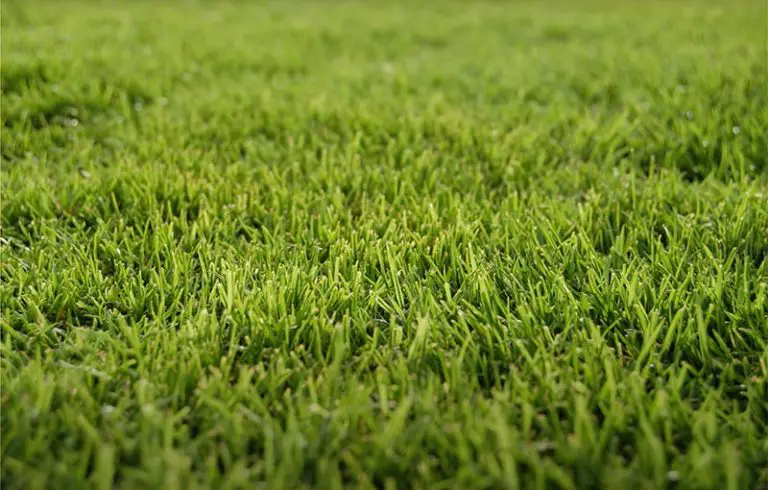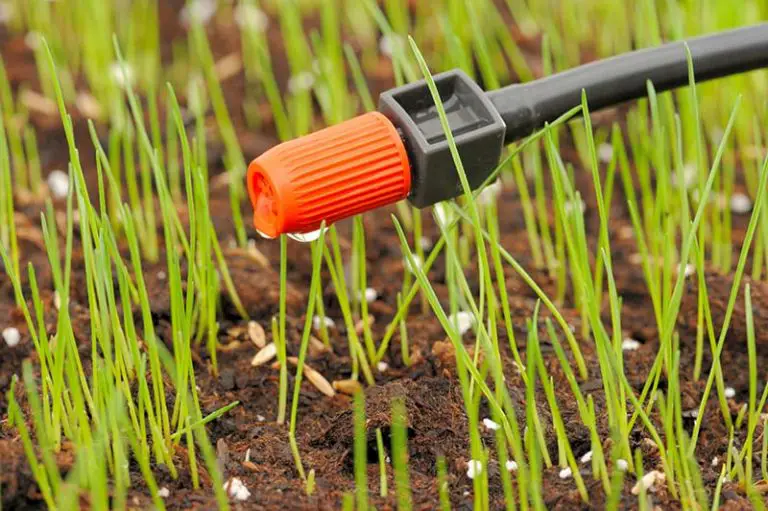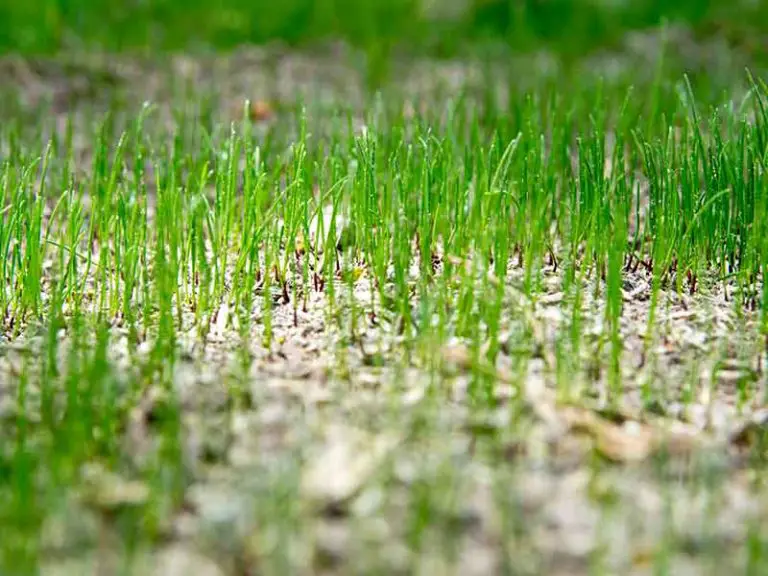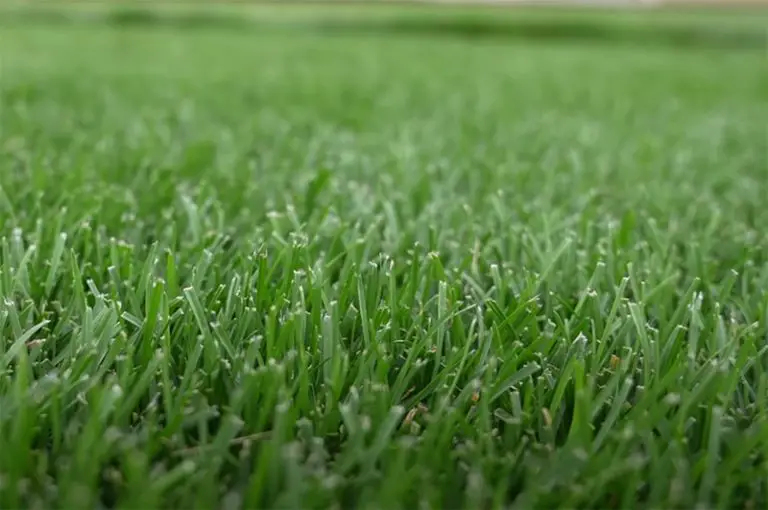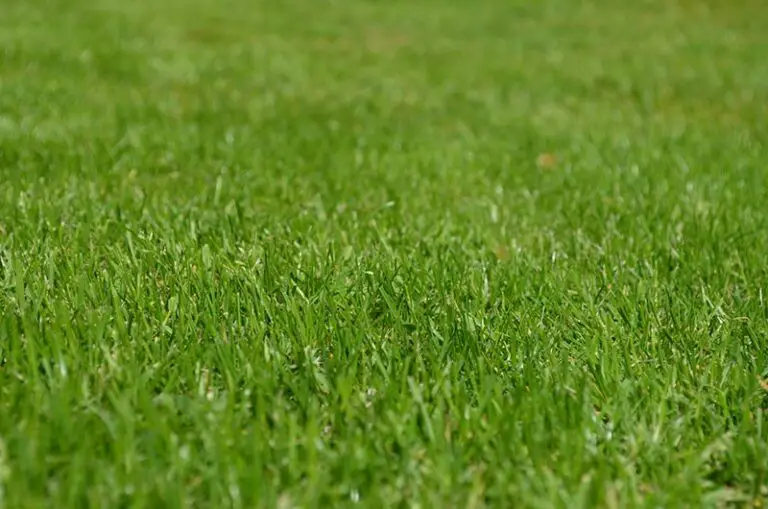Thicken Your Centipede Grass with These Tips
Being a warm-season grass, centipede grass is a popular choice of turfgrass in the southeast states of the US. These regions have the sandy, acidic soils and consistently warm temperatures in which centipede grass thrives. Although this grass is hailed as a low-maintenance grass type, you still need to keep up with general lawn maintenance activities to keep your lawn thick and healthy.
To make centipede grass spread into a thicker lawn, you need to keep up with proper mowing, watering, and fertilization, in addition to controlling weeds, dethatching, and aerating the lawn when necessary.
What is Centipede Grass?
Centipede grass is a warm-season grass type native to China and Southeast Asia. Due to these origins, centipede grass thrives in the southeast regions of the US where lawns typically contain sandy, acidic soils.
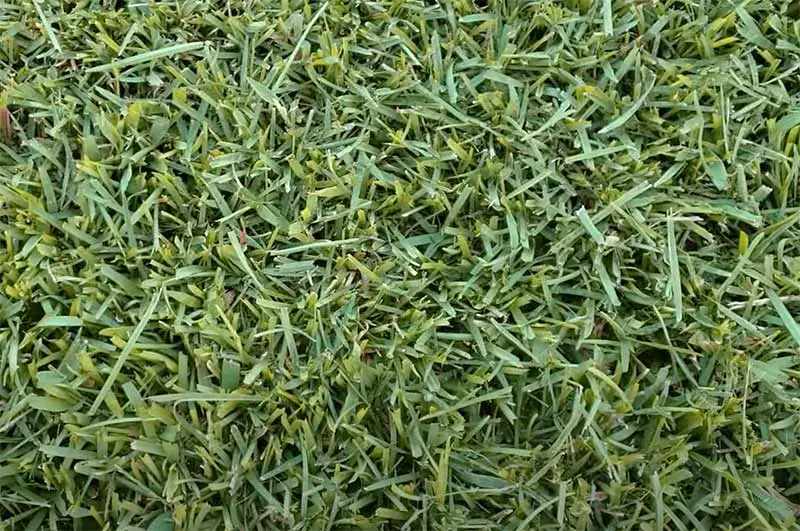
The regions in the US where centipede grass is typically grown include North and South Carolina, throughout the Southern Coastal Plains, stretching to the Texas Gulf Coast. The warmer conditions that last throughout the year into the winter in these regions provide centipede grass with the ideal climate to see the most vigorous growth. Any states to the north of these regions are too cold to support the growth of centipede grass; also, the soils typically found in the Southwest are too alkaline for this grass.
Compared to other warm-season grasses, centipede grass is less tolerant to cold conditions. While it has exceptional tolerance to heat, the same cannot be said for its drought tolerance. Again, in comparison to other warm-season grasses, centipede grass has a relatively shallow root system; this limits its ability to tolerate drought, meaning more care must be taken with watering during periods of low rainfall. This is another reason why the warm, rainy conditions in the Southeast are ideal for centipede grass lawns. Despite its susceptibility to drought, centipede grass can recover quickly from stress once conditions return to normal for its growth.
Characteristics of Centipede Grass
At a glance, the characteristics of centipede grass include:
| Characteristic | Held by Centipede Grass |
| Grass Type | Warm-season grass |
| Where it’s Grown in the US | Southeastern regions including the Carolinas, the Southern Coastal Plains, to the Texas Gulf Coast |
| Maintenance | Low-maintenance |
| Nutrient Requirements | Low nutrient requirements |
| Shade Tolerance | Moderate shade tolerance |
| Cold Tolerance | Low cold tolerance |
| Heat Tolerance | High heat tolerance |
| Drought Tolerance | Low drought tolerance |
| Traffic Tolerance | Low tolerance to traffic |
| Soil Requirements | Sandy, acidic soils |
What Does Centipede Grass Look Like?
Centipede grass is typically yellow-green to light green in color, having thick, coarse blades that grow horizontally to the ground.
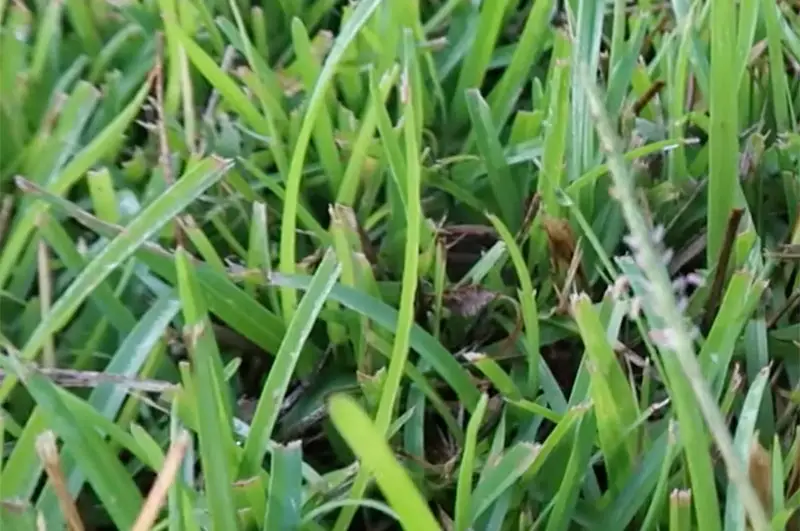
In the milder climates of the southeast where this grass thrives, it’s possible for centipede grass to stay green all winter. It won’t enter a period of winter dormancy (i.e. turn brown) providing temperatures are warm enough.
However, in the absence of a dormant period, centipede grass is more vulnerable to sustaining damage in low temperatures. If the turf suffers repeated injuries from foot traffic or other stressors, it will turn yellow or brown and may die off completely.
How Does Centipede Grass Spread?
Centipede grass spreads through above-ground structures called stolons.
There are two ways in which grasses can spread; either through rhizomes, which are plant stems that grow underground, or stolons, which are stems that grow overground. Centipede grass uses the latter growth method, producing horizontal above-ground runners to spread. These runners have nodes that grow roots and sprout new grass plants wherever they make contact with the soil.
Due to this growth pattern, centipede grass tends to create a thick, lush lawn. However, the over-ground stems are more vulnerable to damage from foot traffic as they’re more exposed. On top of this, centipede grass generally has a slow growth habit relative to other warm-season grasses.
How To Plant Centipede Grass
As is the case with the majority of grass types, you can plant centipede grass from seed, sod, or grass plugs. Seeding centipede grass will require the most time to become a fully established lawn, while sod and grass plugs will create a more immediate lawn.
How to Plant Centipede Grass Seed
Planting centipede grass seed is the cheapest option of growing a centipede lawn. However, it will also require the longest time before the grass grows into a full thick lawn. Centipede grass seed takes between 3 and 18 months to germinate; from seed, it typically takes centipede grass 2 to 3 years to become fully established.
Method:
1. Purchase your desired centipede grass seed.
2. Prepare the planting area; if overseeding, remove excess thatch by dethatching the lawn, and if growing an entirely new lawn, remove the old grass. Loosen and aerate the soil using a rake or alternative aerating tool.
3. Add a starter fertilizer to the planting area. Starter fertilizer contains the ideal balance of nutrients to encourage root development in the new grass.
4. Using a broadcast or drop spreader, apply the seed at a rate of 0.25 to 0.5 lbs. of seed per 1000 square feet of soil. It may help to mix the grass seed with sand at a ratio of 1 lb. seed to 1 gallon of sand.
5. Water the planting area to moisten the top few inches of soil. Continue by watering the new grass so the top few inches of soil are consistently moist, doing so until the seedlings grow to be about 2 inches tall; it may take 10 to 30 days for the grass to reach this height.
How to Plant Centipede Grass Sod
Centipede grass sod is the most expensive option of getting a centipede lawn. Comparing sod vs seed, although sod is more costly, it produces the appearance of a new lawn immediately. Sod also requires much less maintenance than seed as the grass in sod is already mature.
Method:
1. Prepare the soil for sod by tilling the soil to a depth of 6 to 8 inches; this will break up compaction, enabling the grass to grow deeper roots and improving the circulation of water and nutrients around the root layer.
2. Top dress the soil with a layer of organic matter such as well-aged compost to give the planting area a boost of nutrients.
3. Schedule your sod delivery for the day you intend to lay it.
4. Lay the sod on the same day as delivery. Place the strips of sod on the planting area end-to-end, staggering each row to create a brick pattern.
5. Immediately after laying it, water the new sod to moisten the top inch of turf. In the following few weeks, keep the first inch of soil consistently damp.
How to Plant Centipede Grass Plugs
An alternative method of planting to seed and sod is to plant centipede grass plugs. Grass plugs are individual segments of sod that contain the grass, its roots, and a section of soil. This method is best when planting on small areas or fixing certain portions of a lawn.
Method:
1. Prepare the planting area for the grass plugs; wherever you plan to plant the plugs, remove all vegetation and debris before tilling the soil to a depth of 4 to 8 inches.
2. The night before planting, water the planting area to moisten the soil.
3. Place the plugs on the soil atop where you plan to plant them. Space the plugs to leave about 6 to 12 inches of soil between each plug.
4. Measure the root ball of the grass plugs or make a guess of their approximate size by eye. Then, dig holes for each plug that measure the same width and depth of the root ball. You can do this using a shovel or plugger. Make sure that the holes are not so deep that the upward growth of the plugs will be covered once they’re planted.
5. Place a starter fertilizer at the bottom of each hole, adding the correct quantity as stated on the fertilizer’s packaging.
6. Plant the plugs into the holes before filling in any gaps with soil. Again, take care not to cover the top of the plug with soil; only the root ball should be covered.
7. Water the planting area to moisten the top inch of soil.
How to Make Centipede Grass Spread
Although it’s hailed as a low-maintenance grass type, you still need to keep up with some maintenance activities to get your centipede grass to grow and spread. You can make your centipede grass spread through proper mowing, watering, fertilization, weed control, dethatching, and aeration.
Proper Mowing for Centipede Grass
Due to its slow growth habit, you won’t need to mow centipede grass as often as other grass types. However, mowing will still be necessary to keep centipede grass at the best height for its species. You should mow enough to maintain centipede grass at a height of 1 to 1.5 inches. Allowing the grass to grow any taller than this will put stress on the grass plants; its shallow root system won’t be able to keep up with the upward growth.
When planning how often to mow your centipede grass to this height, you should follow the ⅓ rule. This rule dictates that you should only take off ⅓ of the grass’ total height per mowing session; i.e., allow the grass to grow no more than 2 inches before taking off ⅓ of the grass height. A further tip for mowing your grass is to use sharp mower blades otherwise they will tear the grass, leaving it more susceptible to stress and the development of disease. As a general rule, sharpen your mower blades every 25 hours of run time.
Proper Watering in Centipede Grass
In the typical climate of the coastal plains, there should be enough rainfall throughout the spring and summer to keep centipede grass healthy. However, during periods of drought or over the drier winter months, you may need to water once per week.
You’ll know your centipede lawn requires more water when the blades wilt and/or take on a bluish color. If the grass goes through a prolonged period of drought, it may turn brown and appear dead; this isn’t a concern as it is simply in a state of dormancy and will green back up when conditions are favorable for growth again. Continue to water the grass during dormant periods to prevent it from dehydrating and dying off.
With that said, the watering requirements are greater if you have recently planted your centipede lawn. After seeding, sodding, or plugging, water your lawn at least twice per day for the first three weeks. This will encourage the grass to properly develop its root systems. Once the grass finishes germination, follow the regular watering requirements for centipede grass as detailed above.
Proper Fertilization for Centipede Grass
Although frequent fertilization isn’t necessary to make centipede grass spread, it will benefit from minimal applications of a high nitrogen fertilizer. For sandy soils, add less than 2 lbs. of nitrogen per 1000 square feet of soil annually to keep it healthy. If you have clay-heavy soil, add less than this to avoid overfertilization.
Take care not to add more than the previously recommended amount of nitrogen to your centipede grass lawn. Having too much nitrogen in the soil results in fertilizer burn, a condition that causes the grass to turn brown and die off. Overfertilization also encourages thatch build-up and will leave the lawn more susceptible to the development of disease.
The best practice when fertilizing any type of grass is to first test your soil. A soil test will reveal the current nutrient content of the soil, including its levels of nitrogen, phosphorus, and potassium. From the results of this test, you can determine which fertilizer will best suit the nutritional needs of your particular lawn.
Keeping Up With Weed Control in Centipede Grass
Weed infestations of common lawn weeds like crabgrass, goosegrass, and sandburs will compete with your centipede grass for nutrients and water. If you neglect to keep up with other care activities like proper watering and fertilization, the grass will be weak and thin; this leaves more space for the weeds to move in and outcompete your lawn.
To prevent the development of weeds in the first place, apply a preemergent herbicide in the early spring. This type of herbicide will kill any weed seeds before they germinate and get a foothold in your lawn.
For established weeds, you should instead use a post-emergent herbicide or natural weed killer. You should apply these weed killers when the weeds are actively growing and the soil temperature is below 90°F. Avoid treating your lawn with herbicide when the turf is suffering from stressful conditions like drought or disease; wait until the grass has fully greened back up before using such treatments.
Dethatching Centipede Grass As Necessary
A thick layer of thatch will prevent your centipede grass from spreading and growing. Thatch is the layer of organic matter that sits on the soil line. It accumulates from the shed roots and stems of the grass, along with other decaying lawn debris. The buildup of thatch is exacerbated by overfertilization and overwatering of the lawn, or if the lawn grows longer than 2 inches tall.
In excess, thatch hinders the growth of centipede grass as it forms a barrier that covers the soil surface. This causes the grass to grow roots into the thatch layer rather than the soil; it also blocks water, fertilizer, and herbicide or pesticide treatments from reaching the soil surface and penetrating the turf. All of these effects ultimately stunt the healthy, normal growth of the grass.
A thatch layer that measures less than ½ inch won’t cause any issues with the grass. However, when the thatch layer builds up to be thicker than ½ inch, it must be reduced to maintain the grass’ health. For smaller lawns, it’s possible to dethatch with a rake; for larger lawns, you may need to use a mower attachment or dethatching machine to tackle the thatch. You can also break down thatch by top dressing the lawn with a thin layer of organic matter.
Aerating Centipede Grass
Aeration is another way to both reduce the thatch layer and improve the growing conditions in the lawn for your centipede grass to spread. In addition to reducing thatch, the aeration process works to break up compact soil. This creates more space in the soil for the movement of air, water, and nutrients. On top of this, well-aerated soil enables the grass plants to grow more extensive roots that are better able to access these substances in the turf.
If you have sandy soil, these soils are naturally well-aerated due to their structure; therefore, it should only be necessary to aerate a sandy-soil lawn every 2 to 3 years. Clay-heavy soils require more frequent aeration due to their dense structure and susceptibility to compaction; it’s therefore necessary to aerate clay-heavy soils annually to keep them in good growing condition.
Best Grass to Mix with Centipede Grass
The best grasses to mix with centipede grass are Bermuda grass, St. Augustine grass, and dwarf fescue. Mixing these grasses with centipede will improve the lawn’s tolerance for shade and traffic; these are two traits that centipede grass lacks. Mixing centipede grass with the aforementioned grasses will also generally improve the aesthetics of the resulting lawn.

